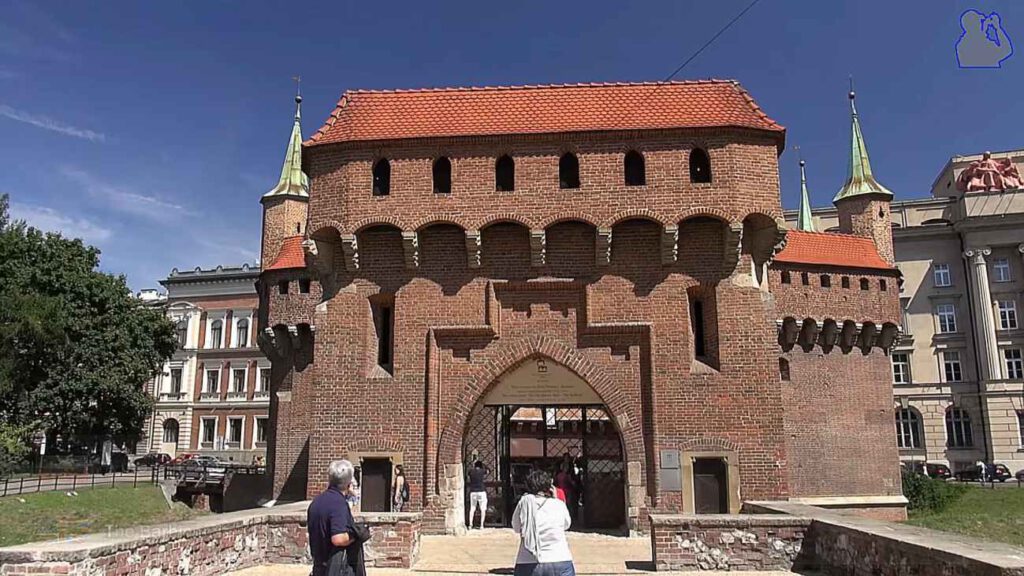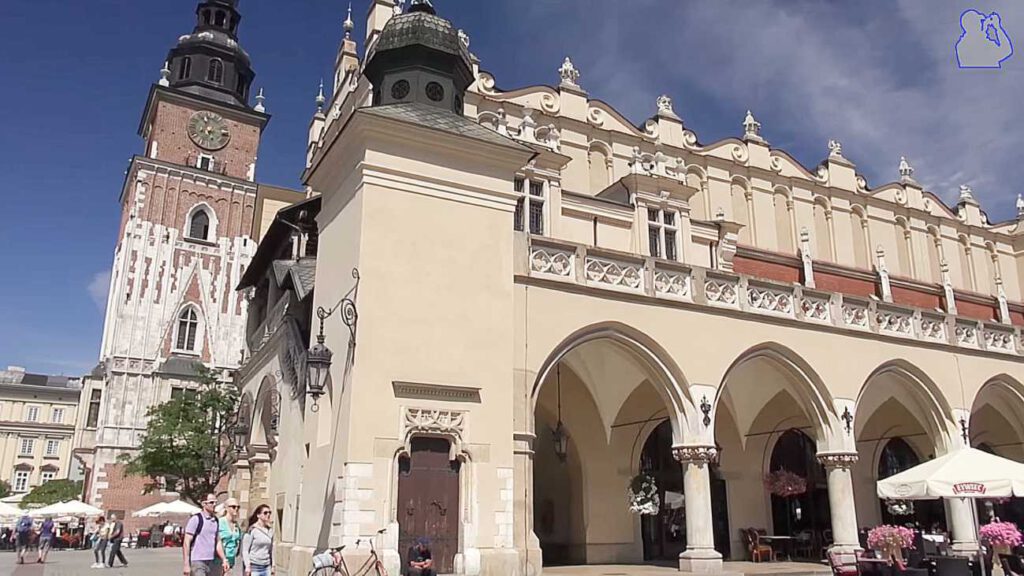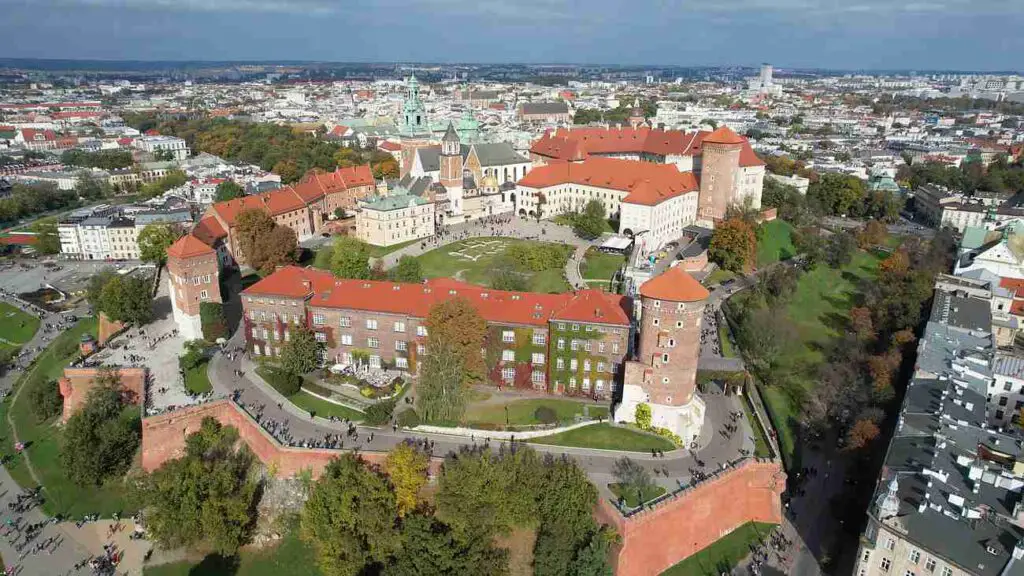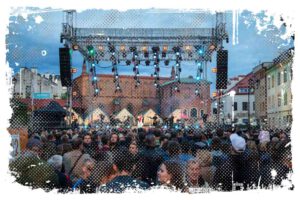I will assure you – if you find yourself in Krakow, the Royal Route should be on your list. It’s like a magnet, drawing tons of tourists each year. The name ‘via regia’ harks back to an era when grand royal processions meandered to the Wawel Hills for extravagant celebrations. Now, I can tell you, if you want a taste of Poland’s old capital, start by exploring the Royal Castle, Wawel Cathedral, St. Mary’s Church, and the Cloth Hall.
And it’s worth to say that these are all nestled on Europe’s largest medieval Market Square. Oh, and let’s not forget the remnants of defensive walls with St. Florian’s Gate and Barbican. Strolling along the “Royal Route”, you’ll witness these rich cultural treasures and more.
I think it’s the constant bustle and extraordinary ambience of the Market Square that makes it a magnet for night owls who love gazing at beautifully illuminated monuments.
The journey begins at Matejko Square and takes you past the Barbican, through Florian Gate, Floriańska Street, the Main Market Square, and along Grodzka and Kanonicza Streets all the way to Wawel Hill.
↳ Make sure to read my guide to the most amazing places to stay in Kraków:
How to Find Best Place to Stay in Krakow Old Town – Your Guide

Being there, you need to know that this path has roots stretching back to ancient times, echoing the footsteps of traders who journeyed from south to north on the so-called “amber route” that passed through the ancient king “Krak’s” dwelling place.
Royal Route’s Most Interesting Places
Strolling through the Royal Route is like walking in the footsteps of kings, as it was this very route the monarchs would take when they ventured into the city heading for their stronghold, Wawel. The journey traditionally started near the railway and bus station, and down the bustling Floriańska and Grodzka streets, where you’ll find the city’s crown jewels of architecture.
I believe it’s fascinating to note that in its glory days, Krakow was encircled by fortified walls. Today, you can still see fragments of these walls, along with the city gate and the Barbican. A moat once circled the walls. Now, it’s been filled in and replaced with walking alleys aptly named – Planty.

St. Florian’s Gate – The Gate of Royal Arrivals
Let me tell you now, St. Florian’s Gate was the city’s main entrance. This is where the king and esteemed guests would make their grand entrance into old Krakow. Seven gates guarded the city, and these were shut tight at night. If you arrived late, tough luck, no entry for you!
Floriańska Street

Floriańska Street is one of Krakow’s most significant streets. This is where royal processions were greeted. As you pass the old houses, it’s worth noticing the emblems above the doors. They were more than just decoration.
Back in the days when houses didn’t have numbers, these emblems were the addresses. Imagine telling folks that you live in the house ‘Under the Squirrel’ or ‘Where the Rams’ are.
Master Matejko’s Workshop
Continuing on Floriańska Street, you’d find the studio of Krakow’s renowned painter, Jan Matejko. If you’ve got some extra time, I can’t recommend enough visiting the museum that now stands in its place. You can see Matejko’s easel, his ‘Under the Stars’ bedroom, and even sketches of angels that adorn the walls of St. Mary’s Church.
St. Mary’s Church
Speaking of St. Mary’s Church, did you know that the bugle call echoing from its tallest tower resounds in all four directions? Inside the church, you’ll find the celebrated historic altar of Veit Stoss, an exceptional European artist. It’s worth to say that Stoss spent 12 years craftng that altar!

While you’re there, I’d suggest looking around for the angels painted on the walls – all the handiwork of Jan Matejko himself! Oh, and don’t miss the martens, hoops where people convicted of petty crimes were chained.
The Cloth Hall
Last but not least, let me tell you now about the Cloth Hall. This used to be where traders peddled their wares, mostly cloth made from sheep’s wool, hence the name. Buildings like these were common in cities along trade routes.
Not just in Poland in cities like Wrocław, Poznań, and Toruń, but also in Europe – places like Dresden and London had them. Look up to see the grotesque faces on the roof – those are mascarons! Another interesting feature to show kids would be the torch extinguishers.

Back when Krakow didn’t have night lighting, people used torches to get around, and these extinguishers were used when they entered buildings.
Now, if you look towards the monument of Adam Mickiewicz on the vault of the Cloth Hall, you’ll see a hanging knife. It’s a chilling reminder of the legend of two brothrs who built the towers of St. Mary’s Church. When one brother’s tower turned out taller and prettier, the other killed him in a fit of jealousy. The knife was hung as a warning at the entrance to the Cloth Hall, where it hangs to this day.
The Ancient Church of St. Adalbert
First on our list is the Church of St. Adalbert. Believe it or not, it’s the oldest church in Krakow. This church was around even before the Market Square and the Cloth Hall!
A Quick Stop on Grodzka Street
As you continue your journey, make your way to 32 Grodzka Street. It’s here you’ll find the oldest surviving emblem in Krakow, the ‘Podelwie’ tenement house. A sight to behold, I assure you.
The Mighty Wawel Castle

Lastly, but by no means least, we have Wawel Castle. Once upon a time, the castle was surrounded by backwaters and swamps.
I think it is worth saying that the name Wawel might’ve come from the word ‘Wawel’, which meant ‘haughtiness among wetlands’.
At Wawel Cathedral, Polish kings were crowned, creating a rich history that lingers till today. Being there, you need to know that one of the most precious relics housed at Wawel is the Szczerbiec – the coronation sword.
But there’s more. From the tower of Wawel Cathedral rings the most famous bell in Poland – Zygmunt. I am convinced that you’ll be surprised to know it takes the muscle and coordination of 8 to 12 people to get Zygmunt swinging!
References:
- https://pl.wikipedia.org/wiki/Droga_Kr%C3%B3lewska_(Krak%C3%B3w)
- https://wtir.awf.krakow.pl/pdf/rozne/trasy/bazy/krolew/index.htm
- https://www.krakow.pl/odwiedz_krakow/1218,artykul,droga_krolewska.html




